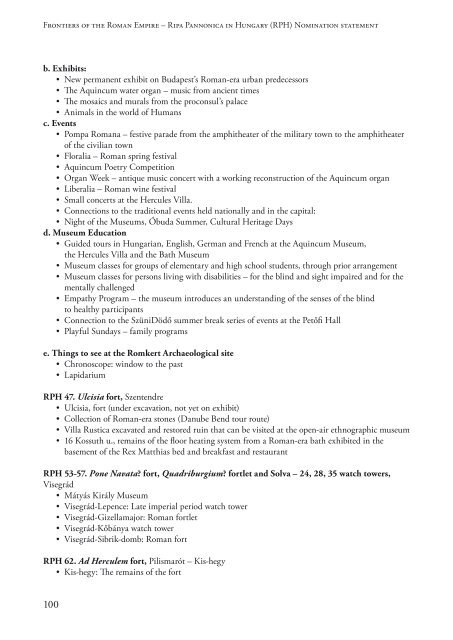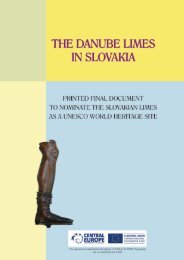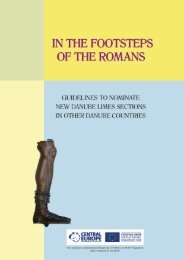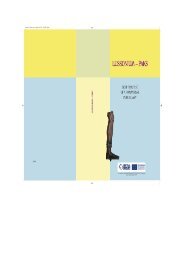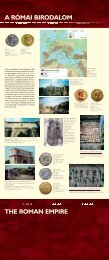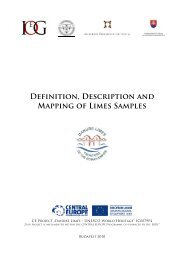the PDF version! - Danube Limes
the PDF version! - Danube Limes
the PDF version! - Danube Limes
Create successful ePaper yourself
Turn your PDF publications into a flip-book with our unique Google optimized e-Paper software.
Frontiers of <strong>the</strong> Roman Empire – Ripa Pannonica in Hungary (RPH) Nomination statement<br />
b. Exhibits:<br />
• New permanent exhibit on Budapest’s Roman-era urban predecessors<br />
• The Aquincum water organ – music from ancient times<br />
• The mosaics and murals from <strong>the</strong> proconsul’s palace<br />
• Animals in <strong>the</strong> world of Humans<br />
c. Events<br />
• Pompa Romana – festive parade from <strong>the</strong> amphi<strong>the</strong>ater of <strong>the</strong> military town to <strong>the</strong> amphi<strong>the</strong>ater<br />
of <strong>the</strong> civilian town<br />
• Floralia – Roman spring festival<br />
• Aquincum Poetry Competition<br />
• Organ Week – antique music concert with a working reconstruction of <strong>the</strong> Aquincum organ<br />
• Liberalia – Roman wine festival<br />
• Small concerts at <strong>the</strong> Hercules Villa.<br />
• Connections to <strong>the</strong> traditional events held nationally and in <strong>the</strong> capital:<br />
• Night of <strong>the</strong> Museums, Óbuda Summer, Cultural Heritage Days<br />
d. Museum Education<br />
• Guided tours in Hungarian, English, German and French at <strong>the</strong> Aquincum Museum,<br />
<strong>the</strong> Hercules Villa and <strong>the</strong> Bath Museum<br />
• Museum classes for groups of elementary and high school students, through prior arrangement<br />
• Museum classes for persons living with disabilities – for <strong>the</strong> blind and sight impaired and for <strong>the</strong><br />
mentally challenged<br />
• Empathy Program – <strong>the</strong> museum introduces an understanding of <strong>the</strong> senses of <strong>the</strong> blind<br />
to healthy participants<br />
• Connection to <strong>the</strong> SzüniDödő summer break series of events at <strong>the</strong> Petőfi Hall<br />
• Playful Sundays – family programs<br />
e. Things to see at <strong>the</strong> Romkert Archaeological site<br />
• Chronoscope: window to <strong>the</strong> past<br />
• Lapidarium<br />
RPH 47. Ulcisia fort, Szentendre<br />
• Ulcisia, fort (under excavation, not yet on exhibit)<br />
• Collection of Roman-era stones (<strong>Danube</strong> Bend tour route)<br />
• Villa Rustica excavated and restored ruin that can be visited at <strong>the</strong> open-air ethnographic museum<br />
• 16 Kossuth u., remains of <strong>the</strong> floor heating system from a Roman-era bath exhibited in <strong>the</strong><br />
basement of <strong>the</strong> Rex Matthias bed and breakfast and restaurant<br />
RPH 53-57. Pone Navata? fort, Quadriburgium? fortlet and Solva – 24, 28, 35 watch towers,<br />
Visegrád<br />
• Mátyás Király Museum<br />
• Visegrád-Lepence: Late imperial period watch tower<br />
• Visegrád-Gizellamajor: Roman fortlet<br />
• Visegrád-Kőbánya watch tower<br />
• Visegrád-Sibrik-domb: Roman fort<br />
RPH 62. Ad Herculem fort, Pilismarót – Kis-hegy<br />
• Kis-hegy: The remains of <strong>the</strong> fort<br />
100


